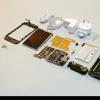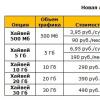In recent years, the so-called "intelligent" batteries, or in other words Smart batteries, have gained popularity. The batteries of this group are equipped with a microprocessor capable of not only exchanging data with the charger, but also regulating the operation of the batteries, informing the user about the degree of their performance. Batteries equipped with a specialized intelligent control system are widely used in a wide variety of technical electrical equipment, including electric transport. It is noteworthy that the group of smart batteries is formed mainly by lithium-containing batteries, although there are sealed or vented lead-acid, nickel-cadmium batteries among them.
Smart batteries are at least 25% more expensive than conventional batteries. However, smart batteries differ not only in price, as most people assume, but also in the features of the adjustment device attached to them. The latter guarantees the identification of the type of rechargeable batteries with the charger, monitors the temperature, voltage, current, and degree of charge of the batteries. significant portion lithium ion batteries nyh modules has a built-in monitoring and control system ( BMS), which is responsible for the condition of the batteries and manages them in such a way as to maximize the performance of the batteries in various conditions.
Let us consider in more detail what a battery with BMS is. Intelligent batteries are batteries equipped with a special microcircuit in which permanent and temporary data are programmed. Permanent data are programmed at the factory and are not subject to change: data relating to the BMS production series, its marking, compatibility with the type of batteries, voltage, maximum and minimum voltage limits, temperature limits. Temporary data is data that needs to be updated periodically. These primarily include operational requirements and user data. As a rule, it is possible to connect the control and balancing system to a computer or controller in order to monitor the condition of the batteries and control their parameters. Some BMS models can be customized different types batteries (voltage levels, current values, capacity).

Battery Management System (BMS) - an electronic system that controls the charge/discharge process battery, is responsible for the safety of its operation, monitors the state of the battery, evaluates secondary health data.
BMS (Battery Management System)- this is an electronic board that is placed on the battery in order to control the process of charging / discharging it, monitoring the condition of the battery and its elements, controlling temperature, the number of charge / discharge cycles, and protecting the battery components. The control and balancing system provides individual control of the voltage and resistance of each battery element, distributes currents between the battery components during the charging process, controls the discharge current, determines the loss of capacity due to imbalance, and ensures safe connection / disconnection of the load.
Based on the received data, the BMS performs cell charge balancing, protects the battery from short circuit, overcurrent, overcharge, overdischarge (high and excessively low voltage of each cell), overheating and hypothermia. The functionality of BMS allows not only to improve the operating mode of batteries, but also to maximize their service life. When determining the critical state of the battery, the Battery Management System reacts accordingly, issuing a ban on the use of the battery in the electrical system - turns it off. In some BMS models, it is possible to maintain a register (recording data) about the operation of the battery and their subsequent transfer to a computer.

Lithium iron phosphate batteries (known as LiFePO4), which are vastly superior to other lithium-ion technology batteries in terms of safety, stability and performance, are also equipped with BMS control circuits. The fact is that lithium-iron-phosphate batteries are sensitive to overcharging, as well as discharging below a certain voltage. In order to reduce the risk of damage to individual battery cells and battery failure as a whole, all LiFePO4 batteries are equipped with a special electronic circuit balancing - battery management system (BMS).
The voltage on each of the cells combined in a lithium-iron-phosphate battery must be within certain limits and be equal to each other. The situation is such that the ideally equal capacity of all cells that make up a single battery is a rather rare occurrence. Even a small difference of a couple of fractions of an ampere-hour can provoke a difference in the voltage level during the charging / discharging process in the future. The difference in the level of charge / discharge of the cells of a single LiFePO4 battery is quite dangerous, as it can destroy the battery.
When the cells are connected in parallel, the voltage on each of them will be approximately equal: more charged cells will be able to draw less charged ones. When connected in series, there is no uniform distribution of charge between the cells, as a result of which some elements remain undercharged, while others are recharged. And even if the total voltage at the end of the charging process is close to ideal, due to even a small recharge of some cells in the battery, irreversible destructive processes will occur. During operation, the battery will not give the required capacity, and due to the uneven distribution of the charge, it will quickly become unusable. Cells with the lowest level of charge will become a kind of "weak point" of the battery: they will quickly give in to discharge, while battery cells with a higher capacity will only undergo a partial discharge cycle.
The balancing method allows avoiding negative destructive processes in the battery. The BMS cell control and balancing system ensures that all cells receive the same voltage at the end of charging. When the charging process approaches the end of the BMS, it balances by shunting the charged cells or transfers the energy of cells with a higher voltage to cells with a lower voltage. Unlike active balancing, with passive balancing, cells that have almost completely replenished the charge receive less current or are excluded from the charging process until all battery cells have an equal voltage level. The Battery Management System (BMS) maximizes battery life by balancing, temperature control and other functions.
Usually stores sell prefabricated batteries with BMS, however, some stores and companies still provide the opportunity to purchase battery components separately. Among them is the company "Electra". Elektra is the first company in Ukraine that decided to supply and create a market for battery cells for self-assembly and design of lithium-iron-phosphate batteries (LiFePO4) in our country. The main advantage of self-assembly of batteries from individual cells is the possibility of obtaining a prefabricated battery kit as close as possible to the user's requests in terms of operating parameters and capacity. When buying components for assembling a LiFePO4 battery, it is important to pay attention not only to the correspondence of the battery cells to each other, but also to look at the BMS parameters: voltage, discharge current, the number of cells for which it is designed. The operation of a lithium-iron-phosphate battery also involves the use of only a charger that meets its type. Its voltage should be equal to the total voltage of the battery.

24v 36v 48v 60v
The main purposes of using BMS (Battery Management System) as a battery regulator:
Protecting battery cells and the whole battery from damage;
Increased battery life;
Maintaining the battery in a state in which it will be possible to perform all the tasks assigned to it as much as possible.
Functions of BMS (Battery Management System)
1. Monitoring the condition of the battery cells in terms of:
- voltage: total voltage, individual cell voltage, minimum and maximum cell voltage;
- temperatures: average temperature, electrolyte temperature, outlet temperature, temperature of individual battery cells, boards BMS(the electronic board, as a rule, is equipped with both internal temperature sensors that monitor the temperature of the control device itself, and external ones that are used to control the temperature of specific battery cells);
- charge and depth of discharge;
- charge/discharge currents;
- serviceability
The cell control and balancing system can store in memory such indicators as the number of charge/discharge cycles, the maximum and minimum cell voltage, the maximum and minimum value of the charge and discharge current. It is this data that allows you to determine the health status of the battery.
Incorrect charging is one of the most common causes of battery failure, so charge control is one of the main functions of the BMS microcontroller.
2. Intelligent computing. Based on the above points, BMS evaluates:
Maximum allowable charge current;
Maximum allowable discharge current;
The amount of energy supplied due to charging, or lost during discharge;
Cell internal resistance;
The total operating time of the battery during operation (total number of operation cycles).
3. Messenger. The BMS can provide the above data to external control devices via wired or wireless communication.
4. Protective. The BMS protects the battery by preventing it from exceeding safe operating limits. BMS guarantees the safety of connecting / disconnecting the load, flexible load management, protects the battery from:
Overcurrent;
Overvoltage (during charging);
Voltage drops below the permissible level (during discharge);
overheating;
hypothermia;
current leakage.
BMS can prevent a process that is dangerous for the battery by directly influencing it or by sending an appropriate signal about the impossibility of subsequent use of the battery to the control device (controller). The intelligent monitoring system (BMS) disconnects the battery from the load or charger when at least one of the operating parameters is out of range.
5. Balancing. Balancing is a method of evenly distributing charge among all cells in a battery, thereby maximizing battery life.
BMS prevents overcharging, undercharging and uneven discharging in individual battery cells:
Carrying out "shuffling" of energy from the most charged cells to the less charged ones (active balancing);
By reducing to a sufficiently low level the supply of current to a practically fully charged cell, at the same time that less charged battery cells continue to receive normal charging current (the shunt principle),
Providing a modular charging process;
By adjusting the output currents of the battery cells connected to the electrical device.
In order to protect the BMS board from the negative effects of moisture and dust, it is coated with a special epoxy sealant.
Batteries do not always have only one control and balancing system. Sometimes, instead of a single BMS board connected via outgoing wires to the battery and the controller, several interconnected regulating electronic boards are used at once, each of which controls a certain number of cells and feeds outgoing data to a single controller.

From a practical point of view, BMS can perform much more than just battery management. Sometimes this electronic system can take part in the control of the parameters of the operating mode of the electric vehicle, and carry out appropriate actions to control its electric power. If the battery is involved in the electric vehicle braking energy recovery system, then the BMS can also regulate the battery charging process during deceleration and descents.
Introduction.
Lithium-ion batteries are the de facto standard in the field of power supplies for electric vehicles, uninterruptible power systems, mobile devices and gadgets. Another example of the use of lithium-ion batteries is storage for renewable energy sources (mainly solar panels and wind turbines). For example, in 2011, China installed a lithium-ion battery storage unit with a total capacity of 36 MWh, capable of delivering 6 MW of electrical power to the grid for 6 hours. An example of the opposite scale is lithium-ion batteries for implantable pacemakers, which have a load current of the order of 10 µA. The very capacity range of a single commercially produced lithium-ion cell has long crossed the 500 Ah mark.
The use of lithium-ion batteries requires compliance with the parameters of the discharge and charge of the battery, otherwise irreversible degradation of capacity, failure and even fire of the battery due to self-heating may occur. Therefore, lithium-ion batteries are always used together with a monitoring and control system - SKU or BMS (battery management system). The battery management system performs protective functions by monitoring temperature, charge-discharge current and voltage, thus preventing over-discharging, overcharging and overheating. The BMS also monitors the state of the battery by assessing the degree of charge (State of Charge, SOC) and the state of fitness (State of Health, SOH). An intelligent BMS is essential in virtually any application of Lithium Ion batteries, providing information on how long the device will run before needing to be recharged (SOC value) and when the battery should be replaced due to loss of capacity (SOH value).
In this paper, we will focus on models for estimating the state of SOC and SOH, suitable for real-time implementation in battery management systems. Unfortunately, in the Russian-language scientific literature there are practically no publications that consider such issues specifically for lithium-ion batteries. Therefore, in this article we will try to fill this gap.
1. Preliminary information.
1.1. Lithium-ion battery - elementary description.
Schematically, the processes of discharging and charging a lithium-ion battery can be represented in Figure 1.
Figure 1. An elementary representation of the processes in a lithium-ion battery.
The battery consists of a carbon anode and a metal oxide cathode also containing lithium (eg LiMn2O4). Positive lithium ions Li+ migrate between the anode and cathode through the organic electrolyte. An important point is that lithium never occurs in a free metallic state - only its ions are exchanged between the cathode and anode. Therefore, such batteries are called "lithium-ion"
When charging a lithium-ion battery, lithium is deintercalated (removed) from the lithium-containing cathode and lithium ions are intercalated (introduced) into the carbon material of the anode. When a battery is discharged, the processes go in the opposite direction: a negative charge is transferred by a stream of electrons from the cathode to the anode, and lithium ions move in the opposite direction - from the anode to the cathode.
We will consider a more detailed description of the processes when modeling a battery at the electrochemical level.
1.2. The system level description of the battery.
From a schematic point of view, the battery appears to be a two-terminal battery. In this paper, its description in the form of a black box will be used, as a system with one input (current in the circuit) and voltage at the battery terminals.
Open circuit voltage (OCV) - voltage at the battery terminals in the absence of current selection.
The most important parameter is the battery capacity, defined as maximum amount electrical energy (in Ah) that the battery delivers to the load from the moment of full charge to the state of discharge, which does not lead to premature degradation of the battery.
As mentioned earlier, the main functions of an intelligent BMS are the estimation of SOC and SOH.
Battery state of charge (SOC) - an indicator characterizing the degree of battery charge: 100% - full charge, 0% - full discharge. The equivalent depth of discharge (DoD) is . SOC is usually measured as a percentage, but in this paper we will assume that . Formally, SOC is expressed as , where is the current charge in the battery.
The battery state of health (SOH) is a qualitative indicator that characterizes the current degree of battery capacity degradation. The result of the SOH rating is not a numerical value, but the answer to the question: “Does the battery need to be replaced now?”. Currently, there is no standard that regulates on the basis of which battery parameters SOH should be calculated. Various manufacturers BMS uses various indicators for this, such as comparing the original and actual battery capacity or internal resistance.
2. Models for determining the state of charge.
Determination of the state of charge SOC is the task of observing the latent states of the system from the available process model and the measured output response from the input action. Models intended for use in battery management systems for SOC determination can be classified into two broad groups:
Empirical models that replicate battery behavior from a "black box" perspective;
Physical models that simulate the internal electrochemical processes in the battery.
2.1 Empirical models.
The class of empirical models includes a number of different approaches, common features are a significant simplified modeling of physical processes in a battery. Empirical models are the standard for implementing BMS, since, on the one hand, they have sufficient simplicity for implementation, and, on the other hand, they have acceptable accuracy for estimating SOC , . A quantitative comparison of 28 different empirical models is contained in the work.
The main type of empirical models is substitution schemes.
The starting premise for empirical modeling is the observation that the battery dynamics can be divided into two parts,:
Slow dynamics associated with battery charge and discharge,
Fast dynamics associated with the internal impedance of the battery: active resistance of the electrolyte and electrodes, as well as electrochemical capacitances.
The processes of aging and degradation of the capacitance are modeled as non-stationarity of the system parameters.
In fact, slow dynamics is reduced to modeling the effect of SOC on the electrical characteristics of the battery. It is noticed that the open circuit voltage (OCV) is a fairly unambiguous function of the state of charge (SOC or DoD):
and is weakly subject to temperature variation (except for areas where the battery is almost fully charged or discharged), and also changes little with battery aging (assuming when the battery is charged to its current level, taking into account capacity degradation).
Typical curves for lithium-ion batteries with different chemistry are shown in Figure 2.

Figure 2. Typical open circuit voltage versus state of charge.
Dependency approximation can be performed in various ways, including piecewise linear or polynomial. One of the classical versions of approximation (1) is Shepherd's equation (Shepherd model), the modification of which for a lithium-ion battery has the form:
where the coefficients are calculated based on the characteristic points of the battery discharge curve, which is usually given in the technical documentation, and is the total charge passed from or into the battery during the time: .
In the work, for example, the following expression is used for approximation:
Various variants of parametrization are systematically considered in the work.
To obtain a complete battery model, equation (2) can also be supplemented with terms that depend on the battery current, for example, as implemented in the Simulink system in the Battery block from SimPowerSystem (, ).
2.1.2 Internal battery impedance.
The second part of the empirical model is the description of the internal impedance responsible for current-voltage characteristics and fast dynamics.
by the most simple option simulation is connected in series with an adjustable source of EMF active resistance (Figure 3). This equivalent circuit simulates the internal resistance of the battery, created by the materials of the electrodes and electrolyte, on which there is an ohmic voltage drop and heat generation.

Figure 3. Elementary battery equivalent circuit.
To simulate transient processes in a battery, such the simplest circuit substitution must be supplemented with reactive elements. Thus, a complex resistance with impedance is connected in series with .
Usually, the following electrochemical phenomena are distinguished, which significantly affect the dynamics of electrical transient processes (, ):
Classical double electric layer in electrode-electrolyte contact (Double-Layer)
Formation of a passive film (solid-electrolyte interface, SEI) on the electrodes.
As a result of these factors, electrochemical distributed capacitors appear inside the lithium-ion battery. The study of battery impedance is carried out using electrochemical impedance spectroscopy (Electrochemical Impedance Spectroscopy, EIS) -.
A fairly large number of equivalent circuits have been proposed - ranging from simple ones containing several reactive elements to detailed modeling of electrochemical phenomena using a large number of RC circuits, and even nonlinear elements.
The practically well-proven version (Figure 4) of the equivalent circuit is based on a series connection of active internal resistance and two RC circuits that simulate polarization processes with the formation of bulk capacitances:
Double layer electrochemical capacitance, whose effect is observed at higher frequencies,
Capacitance associated with lithium intercalation and mass transfer, dominating at low frequencies.

Figure 4. Equivalent circuit for a second-order dynamic battery model.
Thus, the second-order dynamic model presented in Figure 4 in the state space is written as:
where , and the parameters are selected on the basis of experimental data taken from a particular type of battery.
In reality, the battery impedance is a function of temperature and SOC, and in the long term it also changes as the battery ages.
The internal resistance decreases with increasing temperature, but within the range of 25-40°C, it remains quite stable. Experiments carried out with polymer lithium-ion batteries have shown that the equivalent circuit parameters remain constant at SOC greater than 20%. At lower SOC values, there is an exponential increase in resistances and an exponential decrease in capacitances.
2.1.3 Simulation of the state of charge.
Since the value of SOC changes during the process of charging and discharging the battery, it is natural to consider SOC as another state of the system, adding a fragment to the equivalent circuit to model it.
The complete equivalent circuit is shown in Figure 5. An isolated circuit with a controlled current source is added to the circuit, providing a current through and equal to the current in the battery circuit. In this way, the discharge and charge of the capacitance is carried out, simulating the capacity of the battery. The voltage across the capacitance is numerically equal to SOC, . The capacitance value is defined as follows:
where is the total battery capacity in Ah, is a correction factor for taking into account the temperature dependence of the battery capacity , is a correction factor for modeling the aging process ( is the number of charge-discharge cycles).

Figure 5. Complete equivalent circuit for a second-order dynamic model.
The resistance models the self-discharge of the battery.
Taking into account the introduced fragment of the circuit, the battery model in the state space is supplemented with one more equation for the variable :
Actually, the task of determining SOC is reduced to the synthesis of an observer for model (3)-(4).
2.2 Physical models.
Some researchers suggest using physical models to predict SOC and SOH. This class of models is based on the use of equations describing electrochemical processes in a battery.
The main advantage of this approach is quite obvious - high modeling accuracy is achieved due to the transition from the empirical to the physical level of model description. The disadvantages are the high computational complexity of the model and a large number of parameters to be identified from experimental data. Despite this, physical models are of sufficient interest for future generations of battery management systems.
There are two classes of physical models presented in the literature:
Single particle model -,
One-dimensional spatial model (1D-spatial model) .
The one-particle model is based on the assumption that each of the electrodes of a lithium-ion cell can be considered as a single spherical particle of a sufficiently large radius (so that its surface area corresponds to the area of the porous cathode or anode of the battery). Changes in concentration and potential in the electrolyte are ignored, as are temperature effects.
The one-dimensional spatial model is a further development of the one-particle model, in which each of the electrodes is modeled as a set of intersecting spheres centered on the same line. This approach makes it possible to more accurately describe the process of intercalation (diffusion) of lithium ions into porous battery electrodes.
Note that even such approximate physical models of lithium-ion batteries are based on partial differential equations, and the synthesis of observers for such objects is a separate non-trivial task.
2.2.1 One-particle model.
The single-particle model is based on the simulation of the following phenomena in a battery: the diffusion of lithium ions into the electrodes and the electrochemical kinetics of ion flow. The processes in the electrolyte (liquid phase) are represented as constant conductivity and are not actually modeled. The schematic structure of the battery in the single-particle model is shown in Figure 6. Next, we briefly reproduce the main components of the model. All equations are assumed to equally satisfy both the reaction conditions at the anode and equally at the cathode (with appropriate parameters).

Figure 6. Schematic representation of a battery in a single particle model.
Lithium intercalation into electrodes is modeled as diffusion, described by Fick's law:
where is the concentration of lithium ions in the electrodes (solid phase), is the diffusion coefficient.
This equation can be rewritten in spherical coordinates
with boundary conditions
Molar diffusion fluxes can be expressed as the current density through the electrode surface:
where is the Faraday constant, is the effective surface area of each electrode.
To assess the state of charge of the battery, it is convenient to move from local concentrations to averaged over the entire volume of the electrodes - :
Direct calculations show that the time derivative is found as
where is the proportionality coefficient, is the battery current.
The electrochemical kinetics is modeled using the Butler-Volmer equation for the molar flux of lithium ions:
in which overvoltages can be expressed as follows
where are the potentials of the positive and negative electrodes, is a function of the concentration of lithium ions on the electrode surface, is the resistance of the electrolyte (liquid phase) and the passive film on the electrode, is the universal gas constant, is the battery temperature.
Equation (7) can be solved for overvoltage, given that the flows are expressed in terms of battery current using (5):
where are constants expressing the exchange current density.
Note that the voltage at the battery contacts is equal to the potential difference , while the potentials can be expressed in terms of (8) using substitution (9). From here, we get the desired
Equations (6) and (10) constitute an electrochemical single-particle model of a lithium-ion battery.
2.2.2 Relationship between the single-particle model and the equivalent circuit.
The concentrations for the positive electrode and the negative electrode are related to each other from equation (6): as , the concentration decreases proportionally, and vice versa. Obviously, the state of charge is proportional to the concentration. Then it is possible to introduce into consideration the quantity as a state of the system, while the concentrations and will depend linearly on : , .
From here, we can write the following equation for in the one-particle model
where is some positive constant.
The term in (10), based on the introduced state, on which and depends linearly on the concentration, can be represented as a function of . The paper proposes the following approximation for :
The rest of (10) is a function of the current , for which the following parametrization is proposed:
where are constant coefficients identified from experimental data.
The state-space model is finally obtained as:
(12)
Comparing (4) and (11), it is quite obvious that the equation of state of charge in the single-particle model (11) is completely similar to the representation by the equivalent circuit (4), while the self-discharge of the battery is not modeled. From the equation in (12) it follows that the function corresponds to the function for the open circuit voltage in the equivalent circuit. But at the same time, in the single-particle model, there is an additional non-linear element with a voltage drop connected in series with the internal active resistance. Unlike the empirical equivalent circuit representation, the electrochemical capacitance of the electrical double layer is not modeled in the single particle model.
The electrochemical single-particle model itself can be represented as an equivalent circuit shown in Figure 7.

Figure 7. Equivalent equivalent circuit for a single-particle model.
Conclusion.
In this paper, we review two versions of lithium-ion battery models for battery management systems. It is shown that the empirical equivalent circuit model is the most common in the literature, easy to implement and flexible in terms of scaling for modeling special phenomena in the battery. The parameters of the model are non-stationary, subject to both the aging process of the battery and variations from the state of charge and temperature. Based on the analysis of recent publications, it was concluded that a promising direction for improving models for a new generation of battery management systems is physical models that quantitatively describe electrochemical phenomena in a battery. It is shown that a single-particle electrochemical model can be represented as an equivalent circuit similar to the empirical model.
Bibliographic list
- Ramadesigan V. et al. Modeling and simulation of lithium-ion batteries from a systems engineering perspective //Journal of The Electrochemical Society. - 2012. - T. 159. - No. 3. – C. R31-R45
- Garanzha A. China made the world's largest battery [Electronic resource] / A. Garanzha - Access mode: http://www.liotech.ru/sectornews_207_503 - Zagl. from the screen.
- Axcom Battery Technology GmbH, CNFJ-500 2V/500Ah product specification [Electronic resource] - Access mode: http://www.axcom-battery-technology.de/uploads/media/Lead_Crystal_Battery_CY2-500.pdf - Head. from the screen
- Pistoia G. (ed.). Lithium-Ion Batteries: Advances and Applications. - Newnes, 2013. - 634 p.
- Lithium Ion Rechargeable Batteries: Technical Handbook, Sony Corporation [Electronic resource] - Access mode: http://www.sony.com.cn/products/ed/battery/download.pdf - Head. from the screen.
- Aligning the parameters of the battery sections provides additional operating time and increases the service life of the batteries [Electronic resource] - Access mode: http://www.scanti.ru/bulleten.php?v=211&p=44 - Head. from the screen
- Rahimi-Eichi H., Ojha U., Baronti F., Chow M. Battery Management System: An Overview of Its Application in the Smart Grid and Electric Vehicles // Industrial Electronics Magazine, IEEE - June 2013. - vol.7, no .2, -pp.4-16
- Chen M., Rincon-Mora G. A. Accurate electrical battery model capable of predicting runtime and IV performance //Energy conversion, ieee transactions on. - 2006. - T. 21. - No. 2. - S. 504-511.
- V. Pop, H.J. Bergveld, D. Danilov, P.P.L. Regtien, P.H.L. Notten, Battery Management Systems: Accurate State-of-Charge Indication for Battery-Powered Applications. ISBN: 978-1-4020-6944-4, In: Philips Research Book Series, vol. 9, Springer, 2008. pp. 24?37.
- Melentjev S., Lebedev D. Overview of Simplified Mathematical Models of Batteries. // 13th International Symposium “Topical problems of education in the field of electrical and power engineering”. - Doctoral school of energy and geotechnology: Parnu, Estonia, January 14-19, 2013. - pp. 231-235
- Tremblay O., Dessaint L. A. Experimental validation of a battery dynamic model for EV applications // World Electric Vehicle Journal. - 2009. - T. 3. - No. 1. - S. 1-10.
- Bochenin V.A., Zaichenko T.N. Research and development of a Li-Ion battery model // Scientific session TUSUR-2012: Proceedings of the All-Russian scientific and technical conference of students, graduate students and young scientists, Tomsk, May 16-18, 2012 - Tomsk: V-Spectrum, 2012 - Volume 2. - from 174-177.
- Weng C., Sun J., Peng H. An Open-Circuit-Voltage Model of Lithium-Ion Batteries for Effective Incremental Capacity Analysis //ASME 2013 Dynamic Systems and Control Conference. - American Society of Mechanical Engineers, 2013. DSCC2013-3979 - P. 1-8.
- Tang X. et al. Li-ion battery parameter estimation for state of charge //American Control Conference (ACC), 2011. - IEEE, 2011. - P. 941-946.
- Zhao J. et al. Kinetic investigation of LiCOO2 by electrochemical impedance spectroscopy (EIS) //International Journal of Electrochemical Science. - 2010. - T. 5. - No. 4. - S. 478-488.
- Jiang Y. et al. Modeling charge polarization voltage for large lithium-ion batteries in electric vehicles //Journal of Industrial Engineering & Management. - 2013. - T. 6. - No. 2. - S. 686-697.
- Rahmoun A., Biechl H. Modeling of Li-ion batteries using equivalent circuit diagrams //PRZEGLAD ELEKTROTECHNICZNY. - 2012. - T. 88. - No. 7 B. - pp. 152-156.
- He H., Xiong R., Fan J. Evaluation of lithium-ion battery equivalent circuit models for state of charge estimation by an experimental approach //energies. - 2011. - T. 4. - No. 4. - S. 582-598.
- Wang C., Appleby A. J., Little F. E. Electrochemical impedance study of initial lithium ion intercalation into graphite powders // Electrochimica acta. - 2001. - T. 46. - No. 12. - S. 1793-1813.
- Lee J., Nam O., Cho B. H. Li-ion battery SOC estimation method based on the reduced order extended Kalman filtering //Journal of Power Sources. - 2007. - T. 174. - No. 1. - S. 9-15.
- Johnson V. H., Pesaran A. A., Sack T. Temperature-dependent battery models for high-power lithium-ion batteries. – City of Golden: National Renewable Energy Laboratory, 2001.
- Hu X., Li S., Peng H. A comparative study of equivalent circuit models for Li-ion batteries // Journal of Power Sources. - 2012. - T. 198. - S. 359-367.
- Santhanagopalan S., White R. E. Online estimation of the state of charge of a lithium ion cell // Journal of Power Sources. - 2006. - T. 161. - No. 2. - S. 1346-1355.
- Rahimian S. K., Rayman S., White R. E. Comparison of single particle and equivalent circuit analog models for a lithium-ion cell // Journal of Power Sources. - 2011. - T. 196. - No. 20. - S. 8450-8462.
- Bartlett A. et al. Model-based state of charge estimation and observability analysis of a composite electrode lithium-ion battery //Decision and Control (CDC), 2013 IEEE 52nd Annual Conference on. - IEEE, 2013. - P. 7791-7796.
- Moura S. J., Chaturvedi N. A., Krstic M. Adaptive Partial Differential Equation Observer for Battery State-of-Charge/State-of-Health Estimation Via an Electrochemical Model // Journal of Dynamic Systems, Measurement, and Control. - 2014. - T. 136. - No. 1. - S. 011015.
- Klein R. et al. State estimation of a reduced electrochemical model of a lithium-ion battery // American Control Conference (ACC), 2010. - IEEE, 2010. - P. 6618-6623.
- Fang H. et al. Adaptive estimation of state of charge for lithium-ion batteries // American Control Conference (ACC), 2013. - IEEE, 2013. - P. 3485-3491.
In the first chapter of the dissertation work, the well-known methods for approximating the discharge curves of AB at constant current values were considered. These methods are static, i.e. do not take into account the change in the battery discharge mode that constantly occurs on an electric vehicle. When modeling non-stationary loading of a battery, it is necessary to take into account the dependence of the maximum battery capacity on the discharge current. Peukert's equation (2) is the most appropriate for this.
In Fig.3. a simplified algorithm is presented that allows determining the battery voltage at each calculation step in the simulation model of the movement of an electric vehicle.
This approach to the calculation of the non-stationary AB discharge can also be extended to the description of the non-stationary charge that occurs during regenerative braking.
The ultimate goal of developing an electric vehicle model is to determine its performance and battery characteristics in a given driving mode. The following were taken as the main parameters:
mileage (power reserve);
energy consumption during movement;
energy consumption per unit of track and carrying capacity;
specific energy delivered by the battery.
parameters of the battery and (or) energy storage device: a family of temporary discharge and charging characteristics for current values in the operating range at a constant temperature, weight of the battery module and additional equipment, number of installed modules, etc.;
motor parameters: rated current and voltage, resistance of the armature circuit and excitation winding, design data, no-load characteristics, etc.;
parameters of the base vehicle: gross weight, gear ratios of the gearbox and final drive, transmission efficiency, moment of inertia and wheel rolling radius, air resistance coefficient, streamlined surface area, rolling resistance coefficient, load capacity, etc.;
driving mode parameters.
When simulating the EM movement in the SAE j 227 C cycle, the results were obtained with the data structure presented in Table 2.
The results of the factor analysis (Table 3.) showed that already three factors determine 97% of the information, which can significantly reduce the number of latent factors and, accordingly, the dimension of the simulation model.
The results of the calculation of the main performance indicators of the EM during overclocking.
 |  |  |  |  |  |  |  |  | |  |  |
| 1 | 2 | 3 | 4 | 5 | 6 | 7 | 8 | 9 | 10 | 11 | 12 |
| 1,00 | 129,93 | 25,21 | 250,00 | 7,2 | 19,49 | 120,11 | 3,00 | 280,92 | 0,46 | 4487,4 | 0,02 |
| 2,00 | 129,80 | 41,11 | 250,00 | 7,2 | 19,58 | 121,19 | 6,23 | 583,47 | 1,81 | 12873,1 | 0,32 |
| 38,00 | 116,73 | 116,30 | 111,73 | 3,4 | 26,36 | 23,40 | 47,53 | 4449,17 | 393,5 | 828817,1 | - |
The results of factor analysis (Table 3.) showed that already three factors provide 97% of information, which can significantly reduce the number of latent factors and, accordingly, the dimension of the simulation model.
To clarify the analytical presentation of the discharge characteristics of the AB 6EM-145, from which the battery of an electric vehicle with a total mass of 3.5 tons and a battery mass of 700 kg is formed, in order to study the possibility of a short-term recharging of the AB during a work shift and, as a result, an increase in mileage, an experiment was conducted for testing the battery 6EM-145 according to special program. The experiment was carried out for 2 months on 2 batteries 6EM-145.
Informativity of abstract factors
| ^ Eigenvalue | Percentage Variance | Cumulative eigenvalues | Accumulated percent variance |
|
| 1 | 8,689550 | 78,99591 | 8,68955 | 78,9959 |
| 2 | 1,173346 | 10,66678 | 9,86290 | 89,6627 |
| 3 | 0,832481 | 7,56801 | 10,69538 | 97,2307 |
| 4 | 0,235172 | 2,13793 | 10,93055 | 99,3686 |
The tests were carried out according to the following procedure:
Charging with two-stage current 23A and 11.5A (recommended by the battery manufacturer)
Control discharge (as recommended by the manufacturer) with a current of 145A to a minimum voltage value of 9V.
Charge up to 20%, 50% and 80% degrees of charge with currents of 23.45 and 95A.
Discharge current 145A to a minimum voltage value of 9V.
The results of multiple regression for almost all dependent variables showed statistically significant results (the correlation coefficient was equal to R\u003d 0.9989, and F-attitude F(2.6)=1392.8). As a result, the possibility of legitimate use of linear models is shown.
The first stage of acceleration is calculated at the value of the magnetic flux F= F max= 0.0072 Wb and maintaining the armature current at a constant level I i = I i1 = 250 A. This stage starts at the time t= 0 and ends when the duty cycle reaches 1. Constant values for this acceleration stage: excitation current I in = a∙F max 3 + b∙F max 2 + c∙F max\u003d 10.68 A and voltage on the excitation winding U in = I∙R ov
In accordance with the principle of two-zone regulation, an increase in the speed of the motor shaft at full voltage can be achieved by weakening magnetic field. This is implemented in an electronic current regulator that controls an independent excitation winding. The second stage of acceleration begins at the time corresponding to =1 and ends when the electric vehicle reaches the set speed. initial values V, n, U d and others are the results of calculating the last step of acceleration at full flow, when =1.
Multiple regression results
| Statistics | standard error | ^ Score Parameter regression | standard error | statis- teak student to the confidence interval | the level of error in accepting the significance of the regression parameter |
|
| Free member | -0,267327 | 1,944346 | -0,13749 | 0,895142 |
||
| A | 0,005475 | 0,019047 | 0,006819 | 0,023722 | 0,28744 | 0,783445 |
| V3 | 0,999526 | 0,019047 | 1,233841 | 0,023513 | 52,47575 | 0,000000 |
Electric vehicle braking can be mechanical or regenerative. The last step in the cycle begins at time t= t a + t cr + t co and ends when t= t a + t cr + t co + t b. Braking in the SAE j 227 C cycle occurs with constant deceleration, which can be defined as: a= V select /(3.6∙ t b) m/s 2 , where V vyb - speed to the end of run-out, km/h
The simulation experiments carried out in the dissertation work on estimating the characteristics of the motion of the EM showed that the conditionally non-stationary random process of characteristics is well approximated by a process with an autocovariance function of the form:
where r 1 (t) and r 2 (t) are respectively equal to:
| . | (9) |
Analytical expressions are obtained to describe the conditionally non-stationary process. Let the column vector S=(S 0 , S -1 , ... , S -m ) T determines the values of movement characteristics ( t) at moments St=t 0 ,t -1 ,…,t - m , (t 0 >t -1 >.. >t -m ). Then the mathematical expectation is:
where D (t) = (r(t-t 0 ), r(t-t -1 ), ... , r(t-t -m ) row vector of covariances;
D =||cov( (t i ), (t j ))||=||r(t i -t)||, i,j=0..-m - covariance matrix of the process history at moments t i , t j ; r(t) - autocorrelation function of the stationary mode of movement.
Stochastic approximation algorithms were selected as control algorithms for EM motion modes in the dissertation. Let be ^x vector variable in R N, for which the following conditions are satisfied:
1. Each combination of controlled parameters X corresponds to a random variable Y movement characteristics with mathematical expectation M Y(X).
2. M Y(X) has a single maximum, and second partial derivatives 2 M Y/x i x j are limited on the whole area of change of control modes.
3. Sequences ( a k) and ( c k) satisfy the conditions:
| a)  , b) , b)  , in) , in)  , G) , G)  . . | (12) |
4. The recurrent sequence of random control modes is determined based on the transition by the sign of the increment: .
5. Vector Y k of changes in movement characteristics is determined based on the implementation of random values of current modes X k according to one of the plans P 1 , P 2 or P 3:
P 1 =[X k , X k+c k E 1 , . . . , X k+c k E i , . . . , X k+c k E N ] T - central plan;
P 2 =[X k+c k E 1 , X k -c k E 1 , . . . X k+c k E N, X k -c k E N ] T - symmetrical plan;
P 3 =[X k , X k+c k E 1 , X k -c k E 1 , . . . X k+c k E N, X k -c k E N ] T .- plan with a central point, where .
6. Dispersion of assessment of movement characteristics k 2 for each combination of modes X k limited k 2 2
The research carried out in the dissertation showed that under the above conditions, the sequence of the selected control modes X k with probability 1 converges to optimal values.
As a result of the carried out formalization, the functioning algorithm of the controlled simulation model of EM movement is the following sequence of actions:
1. Initial setup of the model and selection of initial modes of movement X 0 , k=0.
2. With a given combination of modes X k in its local neighborhood according to one of the plans P i (i=1,2,3) selective trajectories of movement characteristics are generated ( Xk,l ( t|s k)) l=1 L duration T each from a common initial state s k .
3. Mean integral estimates of characteristics are calculated for all l=1
…L with a common initial state s k :
6. Set the initial state s k +1
next control interval, equal to the final state of one of the processes of the previous step.
7. In accordance with the selected stop criterion, a transition is made to point 2, or to the end of the simulation.
In the fourth chapter the developed methods and models were tested.
When choosing the dimensions of the battery installed on the EM, to optimize the ratio between the carrying capacity and the mileage of the electric vehicle, the concept of transport work is used A=G E ∙L t∙km, where G E– load capacity of EM, t; L- power reserve EM (mileage). Load capacity EM G E =G 0
- m b / 1000 t, where G 0
=G BUT –
m– chassis load capacity, determined by the load capacity of the base vehicle G BUT including weight m, released when replacing the internal combustion engine with an electric drive system, t; m b is the mass of the energy source, kg. Mileage value L electric vehicle in the general case is calculated according to the formula known in the literature  km, where E m- specific energy of the current source, W∙h/kg;
- specific energy consumption during movement, W∙h/km. As a result, for transport work it is true:
km, where E m- specific energy of the current source, W∙h/kg;
- specific energy consumption during movement, W∙h/km. As a result, for transport work it is true:
| t∙km, | (15) |
where: coefficient  km/kg.
km/kg.
Based on the developed simulation model, the calculation of the movement of the EM was carried out on the basis of the GAZ 2705 "GAZelle" car with a carrying capacity G 0 =1700 kg. The calculation was carried out for sources assembled from 10 series-connected OPTIMA D 1000 S battery blocks. G BUT .
The calculations were carried out for movement in the cycle S AE j 227 C and for movement at a constant speed. In Fig.4. shows the theoretical and obtained by simulation of the dependence of the transport work on the mass of the battery.

According to the results of the calculation, the maximum transport work is achieved with a mass of batteries slightly larger than half the load capacity. This is due to the increase in specific energy E m current source with increasing capacity.
Cycle S AE j 227 C is one of the most intense test cycles, non-stop driving, on the contrary, is one of the easiest. Based on this, it can be assumed that the graphs corresponding to intermediate driving modes will be located in the area limited by the corresponding curves, and the maximum transport work when working on the OPTIMA D1000S battery lies in the range from 920 to 926 kg.
In custody the main results of the work are presented.
Appendix
contains documents on the use of the results of the work.
^
Main conclusions and results of the work
The classification of ABs and the analysis of known methods for calculating the characteristics of ABs have been carried out. An assessment of the possibility of their application in modeling the non-stationary charge and discharge of AB is given.
Based on the research carried out in the dissertation for modeling non-stationary loading of AB under various modes and conditions of EM motion, it is proposed to use a decomposition approach that allows integrating hybrid analytical and simulation models, including models of the mechanical part, control system, motion modes, and others.
The paper posed and solved the problem of formalizing the principles of constructing an EM simulation model using a process description of objects and components of the system, which allows simulating non-stationary modes of EM movement and their influence on the non-stationary loading characteristics of AB.
A factor analysis of overclocking characteristics was carried out, which showed that already three factors explain 97% of the information. This made it possible to significantly reduce the number of latent factors of the model and, thereby, the dimension of the simulation model.
A technique for conducting an experiment on a comparative analysis of the characteristics of the discharge of batteries has been developed and experiments have been carried out. The obtained experimental data showed that for almost all dependent variables it is legitimate to use linear models.
The simulation experiments carried out to assess the characteristics of the movement of the EM showed that the non-stationary random process of characteristics is well approximated by a process with a hyperexponential autocovariance function. Analytical expressions are obtained to describe the characteristics of a conditionally non-stationary process.
To solve optimization problems on a simulation model, stochastic approximation algorithms are chosen as control algorithms, which provide high speed convergence under conditions of large dispersions of motion characteristics.
A software-simulating complex has been developed, which is implemented for practical application in a number of enterprises, and is also used in the educational process at MADI (GTU).
Publications on the topic of dissertation work
Research results published in 6 printed works.
Ioanesyan A.V. Methods for calculating the characteristics of batteries for electric vehicles / E.I. Surin, A.V. -M., 2003. - S.29-36.
Ioanesyan A.V. Methods for determining the end of the discharge and charge of the battery on an electric car / Ioanesyan A.V. // Electrical engineering and electrical equipment of transport. - M.: 2006, No. 6 - pp. 34-37.
Ioanesyan A.V. Basic parameters of batteries for electric vehicles / A.V. Ioanesyan // Methods and models of applied informatics: Interuniversity Sat. scientific tr. MADI (GTU). - M., 2009. - S.121-127.
Ioanesyan A.V. Model of the mechanical part of the electric car / A.V. Ioanesyan // Methods and models of applied informatics: Interuniversity Sat. scientific tr. MADI (GTU). - M., 2009. - S.94-99.
Ioanesyan A.V. Generalized simulation model of the movement of an electric car / A.V. Ioanesyan // Principles of construction and features of the use of mechatronic systems: Sat. scientific tr. MADI (GTU). - M., 2009. - P.4-9.
Ioanesyan A.V. Models of non-stationary processes of electric vehicle movement / A.V. Ioanesyan // Principles of construction and features of the use of mechatronic systems: Sat. scientific tr. MADI (GTU). - M., 2009. - S.10-18.
Today in Russia there is an increase in manufacturers of autonomous electric vehicles of small and medium power. These include not only electric vehicles and urban transport. Electric traction is successfully used for the sale of loaders, warehouse and agricultural equipment, in fishing and hunting areas for silent hunting and fishing (buggies, boats, ATVs), as well as in sports and entertainment areas.
The manufacturers of most of these vehicles use a medium power drive and lithium batteries as power sources. To ensure the correct and safe operation of such a system, it is necessary to control the charge of each battery cell. Most manufacturers use ready-made control systems for this ( BMS) foreign production (PRC, USA, Germany).
The most efficient lithium power supplies widely used in electric vehicles, by their nature, give out an operating voltage of the order of 3.2 ... 4 V. To ensure the operation of the electric drive at a higher voltage, they are connected in series. With this configuration in the battery, in the event of a change in the parameters of one or several cells, an imbalance may occur - overcharging, overdischarging of cells, reaching 30% in the worst case. This mode significantly (at times) reduces the battery life.
System BMS allows you to control and balance the charge in series and in parallel-series connected battery cells of the battery of an autonomous electric vehicle.

There are 2 main types of battery cell balancing: active and passive.
When the threshold voltage is reached, the passive balancing system begins to dissipate energy on the resistor in the form of heat, while the charging process stops, then, having reached the lower threshold voltage, the system starts charging the entire battery again. The charging process stops when the voltage of all cells is in the required range.
Passive balancing is a unidirectional system, it can only absorb the charge of the cell. The active balancing system uses bi-directional DC/DC converters, thereby allowing energy from a more charged cell to be directed to a more discharged cell under the control of a microcontroller BMS. The matrix switcher provides routing of charges to or from the cell. The switch is connected to DC-DC the converter that regulates the current, it can be positive when the cell needs to be charged, negative when it needs to be discharged. Instead of using a resistor and dissipating heat, the amount of current flowing during charging and discharging is controlled by a load balancing algorithm.

The most widely used analog systems of passive balancing. The figure shows a typical system and its characteristics.

We have developed a mathematical model of a storage battery consisting of 16 LiFePO 4 cells, the charge control of which was carried out by means of a passive BMS. Mathematical model of the battery LiFePO 4 cells in the system matlab— Simulink takes into account the non-linear charging and discharging characteristics of the battery, corresponding to this type cells, internal resistance, as well as the current level of maximum capacity, which changes during the life cycle of the cell.
A passive balancer was connected in parallel to each of the cells. To control the process of charging and balancing, a key was switched on in series, the opening and closing of which was carried out by a command coming from BMS. The study was carried out for the final stage of charging the battery from an ideal voltage source.

Oscillograms of the battery charging process, consisting of 16 LiFePO4 cells, one of which was “damaged” and had a lower capacity
The figure shows the case when the parameters of one of the cells were changed, in particular, the case of capacitance loss and an increase in internal resistance was simulated, which can happen in real life, for example, as a result of an impact or due to overheating.
The damaged cell charges faster and reaches the required voltage first. However, it is not further charged. According to the principle described above, the balancer begins to work. The rest of the cells marked in green at the moment of stopping the charging process retain the current level of capacity, and at the moment of its resumption they continue to charge.
When the voltage level of all cells reaches the required range, the charging process stops.














